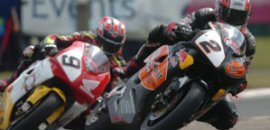Advanced motoringFrom TrackpediaAdvanced motoring or, more specifically, motorsport, is a sport with many genres. First off, it's never anything even close to "road-rage". It's better described as "percision driving". Typically, it's not like road driving, but many good habits from it can be inverted to road driving. Second, it's not called a "sport" for nothing. While it does not nessecarily require to be exceptionally fit to race cars, fitness helps and, in some sorts of motorsport, it's even more important. >==Autocrossing== A cheap, yet satisfying sort of performance driving, which is done in empty car lots or on skidpans, by making a track made of cones, that form "gates" and reference points.
Slalom drivingSlalom driving is normally incorprated into Autocrosses as a simulation of esses in race tracks, or as an independent drill used in pursuit training, defensive driving and race driving training. It's goal is to maximize steerability and stability. In fast slalom courses, the car is being brought to the other edge of lateral traction, and will tend to slip, and the power-steering pump may even fail to support the quick steering inputs efficiently. Slaloms are also made in a 90-degree corner line, or by creating a winding trail by placing cone-gates to the left and right, instead of placing them one after the other in one line. The idea is to seperate acceleration and steering, so that they are apart, but almost overlap (as you go off of the gas, turn the wheel; as the lock is taken off, dab the accelerator). Autocross/GymkhanaThe whole track is called an autocross or gymkhana. It typically includes a slalom, corners of 240 degrees, hairpins, schikanes, even J-turns. Due to sharp and tight cornering and possibly slippery conditions, the driver might incorprate techniques intended to controlably slide the car. Gymkhanas are usually negotiated in first or second gear, third at most. Track racingThe simplest form of motorsport is track racing. This is done in one of three types of automoblies: KartingThese are small, but powerfull autombiles, which don't have to require road driving license to drive. These machines have no suspension, and are greatly effect by the weight of the driver and his leaning. Some karting drivers drift their karts slightly across corners, since the brakes of their karts are quite weak. BikesIn motorsports, driver learn that bikes and cars are quite alike. In a bike, since there is less traction and roll, it is perhaps the most smooth, "neat" and percise. Race carsThese are improved road cars, used to race across race tracks. This is the main focus of Trackpedia, but surely not the only one. This is one of the most developed parts of motorsports, and has various techniques and methods for it. NASCARAn American branch of track racing, where cars are driven around Obelical tracks in tight traffic and bumpings. FormulaFormula driving, which's epitome is Forumla-1, is the peak of track racing, and often considered the peak of motrsport and advanced motoring in general. Formula or F-1 cars are lighter, rear-driven, and more aerodynamic. They are particularly destinguished by the speed of the driving, being able to preduce great amounts of G-force which acts directly on the driver directly, since he seats in an open cockpit. This requires great physical endurance, due to phenomenons of weight lost, sweat and fade-in/fade-out. RallyingThis is another sort of motorsport. Sometimes refered as opposite to track racing and road driving. It is considered a more "messy" sport, and sometimes even refered to as less "percise". It is challenging, due to encountering of various road conditions: Gravel (typical), mud, water, mountains, grass, rocks, tarmac, snow, etc... Drivers have been recorded many times to encounter the wild life, and their cars are often damaged by extreme road conditions, and have to be repaired at stations or mid-stage by the drivers. Because it is not a track, the driver depends on a tango with the pace-notes read to him by the co-driver while he is driving fast. Rally-crossRallying put across a track with tarmac sections and gravel rally sections. Endurance racesThese are races done in off-road cars across obstacle-ridden terrain, which they have to pass without excessive car damage. Stunt drivingThis is driving (or biking) used and judged intentionally by stunts, such as jumps, ski (driving on two wheels), drifting or spinning the car, making J-turns and parallel parking with the E-brake, all in narrow conditions, typically on tracks. DriftingOr Prodrifting. This a new sport, which involves controlling a rear or all-wheel drive beyond the bounderies of control, keeping the car sideways. It should be distinguished from "Powersliding". Drag racingA sport consisting of powering out of a standing start and across a short streach of track. Demolision DerbiesCars are placed in tarmac or gravel rings, where drivers ram each other from the side in order to demolish their opponents' cars. Defensive drivingDefensive driving is a branch of advanced motoring (but not of motorsport), which involves training road drivers, typically by former racing or rally drivers, to deal with possible emergencies on the road, or training them to apply basic motorsport techniques on the road. These typically include drills of emergency braking, a very high (and somewhat over-rated) amount of oversteer control exercise practices in skidcars on on skidpans. They also tend to include instructions on seating positions and steering techniques. Defensive driving must take into acount the limits of road drivers and road driving like: Inability to imitate threshold braking or ABS braking efficiently while in an emergency, Inability of using the racing lines into road driving, etc... |
